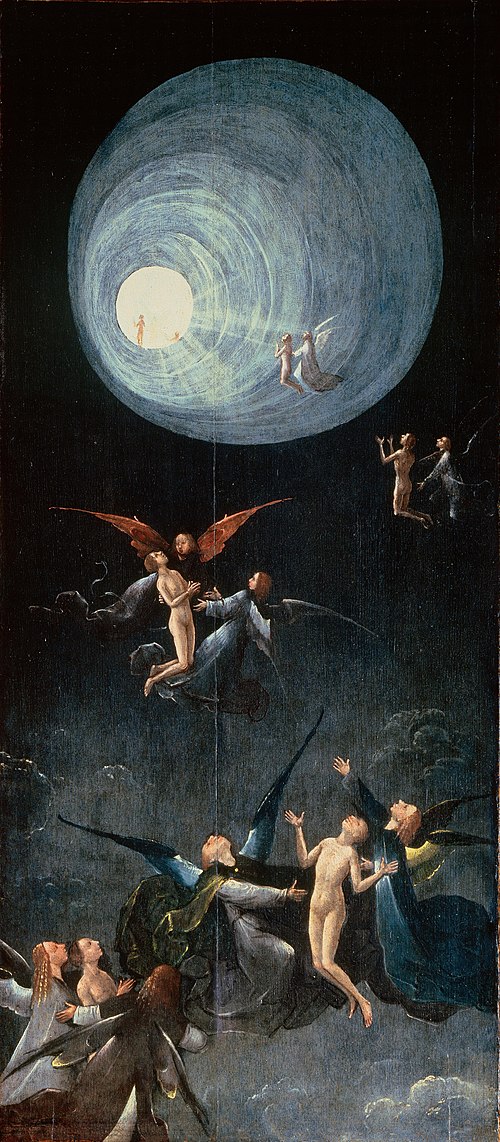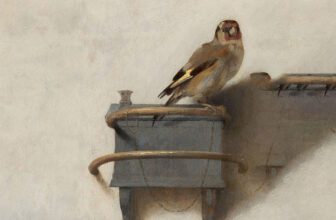
The Celestial Journey: Ascent of the Blessed by Hieronymus Bosch
Among the enigmatic works of the late medieval painter Hieronymus Bosch, one ethereal, haunting, and visionary panel stands out, Ascent of the Blessed. Painted at the turn of the 16th century, this painting immerses the viewer in a dreamlike depiction of the afterlife’s more heavenly aspects, offering a glimpse into the artist’s unique and often spiritually charged imagination. Through masterful symbolism and visionary narrative, Bosch’s Ascent of the Blessed has become a focal point for art historians, theologians, and dreamers alike.
Who Was Hieronymus Bosch?
Hieronymus Bosch (circa 1450–1516) was a Dutch painter born in the town of ’s-Hertogenbosch in the Duchy of Brabant (modern-day Netherlands). Renowned for his fantastical imagery, Bosch’s work is steeped in religious allegory, moralistic tales, and apocalyptic visions. He worked during a time when religious narratives dominated European art, but Bosch distinguished himself by rendering these stories with grotesque figures, otherworldly landscapes, and surreal inventions that seem to prefigure the surrealist movement centuries later.
His style defied the traditional conventions of his time. While most Northern Renaissance painters focused on naturalism and idealized religious scenes, Bosch turned his attention to humanity’s sins, moral consequences, and visions of the afterlife that oscillated between horrifying and sublime. His works are dense with symbolism and require layered interpretation, each figure, each color, and each movement invites speculation.
Bosch’s legacy lies in his deeply original voice, simultaneously medieval and proto-modern, and Ascent of the Blessed stands as a powerful example of this duality.
What Is Ascent of the Blessed?
Ascent of the Blessed (Dutch: Opstijging der Zaligen) is one of four panels that are believed to have once been part of a larger polyptych depicting the afterlife. These panels include:
Ascent of the Blessed
Terrestrial Paradise
Hell
Fall of the Damned
Together, they narrate a journey through the realms of divine judgment: from earthly life through purgatory and hell, to the eternal bliss of heaven. While Bosch’s depictions of hell are famously nightmarish, Ascent of the Blessed is striking for its serenity and transcendental beauty.
This particular panel focuses on the souls of the righteous ascending toward paradise, guided by angels through a glowing, otherworldly tunnel of light. Unlike the grotesque creatures Bosch is often associated with, this painting is delicate, lyrical, and contemplative, expressing hope and the ecstasy of divine union.
What Type of Art Is Ascent of the Blessed?
Ascent of the Blessed is classified within Northern Renaissance art, a style that flourished in Europe north of the Alps during the 15th and 16th centuries. Bosch’s work, however, occupies a unique niche within this movement. While many of his contemporaries emphasized realism, Bosch embraced the mystical and symbolic. His art is characterized by:
Religious allegory
Fantastic imagery
Moralistic tone
Symbol-laden compositions
In particular, Ascent of the Blessed falls within the subgenre of devotional art, art intended not merely for aesthetic enjoyment, but for spiritual contemplation and moral reflection.
Technically, the work is an oil on panel, and measures approximately 87 cm by 40 cm. It’s painted with the careful attention to detail that characterizes the Northern Renaissance, but its vision is unique, less rooted in earthly observation and more in spiritual allegory.
Where Is Ascent of the Blessed Painting Located Today?
Today, Ascent of the Blessed resides in the Palazzo Grimani, a branch of the Gallerie dell’Accademia in Venice, Italy. It is part of the collection of the Museo di Palazzo Grimani, housed in a historic Venetian palace. Despite its relatively modest size, the painting continues to draw art lovers and scholars from around the world due to its profound spiritual resonance and historical significance.
What Is Happening in Ascent of the Blessed?
The painting is a vertical composition divided into several distinct zones, each narrating a stage in the journey of the blessed soul.
Bottom of the Panel: Here, newly deceased souls awaken from death, often depicted nude, symbolizing purity and vulnerability. These figures appear startled or confused, emphasizing the threshold between life and the afterlife.
Middle Section: Angels begin to guide the souls upward. Each angel gently supports or leads a soul by the hand, acting as both protector and guide. These interactions reflect compassion and reassurance. The figures ascend with increasing grace, their expressions softening as they draw nearer to their destination.
Upper Section: A narrowing tunnel of light opens at the top, surrounded by radiant, swirling clouds. The tube-like form culminates in a circular burst of pure light, a divine gateway, perhaps even the threshold to heaven itself. Inside this glowing entrance, indistinct figures appear, perhaps other saved souls, celestial beings, or even Christ.
The overall movement of the composition is upward and inward, drawing the eye toward the vanishing point at the center of the tunnel. Bosch creates a sense of motion and divine pull, suggesting an irresistible gravity toward spiritual perfection.
Symbolism and Interpretation
The painting is rich with symbolic content, much of which is consistent with medieval Christian eschatology, the theological study of death, judgment, and the final destiny of the soul.
1. The Ascent
The act of ascending is central. In Christian theology, the ascent of the soul to heaven is a metaphor for spiritual purification and divine acceptance. Bosch portrays this as both a literal and symbolic movement, elevation of the soul from the material to the spiritual realm.
2. Angels
The angels are not warriors or grand celestial beings here. They are kind, luminous figures whose sole purpose is to guide. Their gentle demeanor emphasizes mercy, love, and divine order. The depiction aligns with the idea of a psychopomp, a being that escorts souls to the afterlife, found in many religious traditions.
3. The Tunnel of Light
Perhaps the most iconic part of the painting, the tunnel has led some modern viewers to draw comparisons to near-death experiences. The radiant, circular endpoint has become a cultural symbol of transcendence. For Bosch, this tunnel could represent:
The path of the soul toward divine light
The aperture of heaven
The narrowing focus of the soul on God as it leaves worldly distractions behind
It echoes Dante’s description in The Divine Comedy, where the soul passes through levels of heaven toward the beatific vision.
4. The Nude Souls
Nakedness in religious art often signifies vulnerability, spiritual purity, and the stripping away of earthly identities. These figures are not sexualized but are presented with humility and clarity. Their expressions shift from confusion to awe, mirroring the soul’s journey toward understanding.
5. Light and Darkness
Bosch uses stark contrasts, bright white light against deep shadows, to highlight the transition from ignorance to divine knowledge. The chiaroscuro isn’t just a visual device but a metaphysical one, showing the emergence of spiritual clarity.
6. Spatial Perspective
The exaggerated vertical perspective, which narrows dramatically at the tunnel’s end, serves not only to create depth but also to symbolize the narrowing path of salvation, “narrow is the way that leads to life” (Matthew 7:14). It visually echoes the idea that salvation requires focus, discipline, and grace.
The Painting’s Place in Bosch’s Oeuvre
While Bosch is often remembered for his monstrous demons, twisted hellscapes, and scenes of debauchery (as in The Garden of Earthly Delights or The Last Judgment), Ascent of the Blessed shows the other side of his spiritual vision.
Bosch wasn’t simply obsessed with damnation, he was profoundly interested in salvation. This painting acts as a counterbalance to his more infernal works, reminding viewers that redemption is not only possible but deeply beautiful.
It is also notable for its emotional restraint. Where Bosch’s hell scenes are teeming with chaotic movement, Ascent of the Blessed is calm, ordered, and infused with hope. It invites the viewer to reflect on their own journey, their own final destination, and the spiritual choices they must make.
Why It Still Matters Today
More than 500 years after it was painted, Ascent of the Blessed continues to inspire debate, reflection, and reverence. In an era dominated by materialism, Bosch’s mystical vision reminds us of humanity’s eternal yearning for meaning, redemption, and transcendence.
The painting speaks across time to fundamental human questions:
What happens after death?
Can we be saved?
What does divine love look like?
Its message, encoded in light, motion, and grace, resonates beyond its Christian context and appeals to a universal longing for peace beyond suffering.
Ascent of the Blessed is one of the most spiritually moving and visually enigmatic works of the Northern Renaissance. Hieronymus Bosch, with his otherworldly imagination and deep moral insight, crafted a vision not just of an afterlife, but of a journey, of the soul rising from confusion and fear to clarity, comfort, and divine embrace.
At once mysterious and deeply human, this painting stands as a quiet monument to the hope that, beyond life’s trials and temptations, a greater light awaits those who seek it.
Whether viewed as a theological statement, a mystical vision, or a psychological metaphor, Ascent of the Blessed remains a breathtaking testament to Bosch’s genius and a luminous beacon in the history of art.




